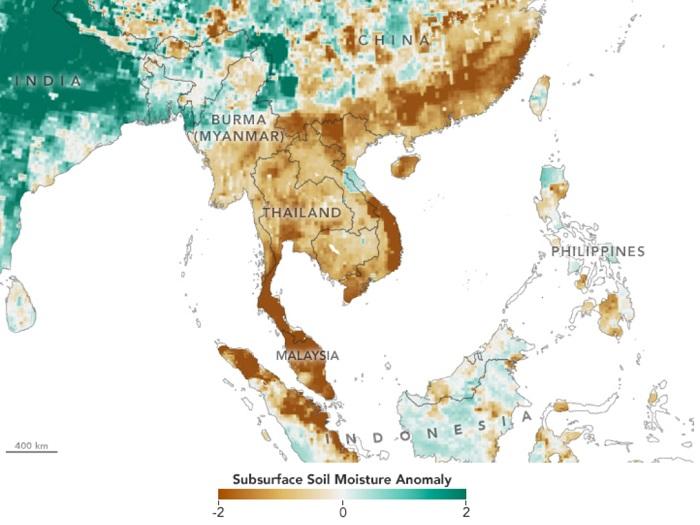- Thailand is experiencing what may be its worst drought in 40 years
- NASA satellite data shows the soil moisture anomalies in drought-hit areas
- NASA’s SMAP mission collects local data that is useful for farmers and water managers
NASA’s Soil Moisture Active Passive (SMAP) mission is an orbiting observatory that measures the water content in the surface soil everywhere on Earth. It is the first NASA satellite that is dedicated to measuring the water content in soil.
Recent SMAP data taken from Jan. 1 to Feb. 7, 2020, shows the areas in southeast Asia where the water content was above or below the norm. In particular, the data shows severe dry conditions in Thailand, which is experiencing its worst drought in four decades brought about by below-average rainfall and shorter than normal monsoon seasons. In fact, the Mekong River Commission (MRC) stated that the monsoon season arrived two weeks late and left three weeks earlier in the Lower River Basin, significantly reducing the amount of normal rain.
About half of the country’s major reservoirs are already below 50 percent capacity and, the fresh river waters have become so low that it can no longer push salt water from the ocean away from cities, causing saltwater intrusion in Thailand’s water supplies including its drinking water.
This is also problematic for the millions of people in Thailand who work in the farming and crop production sectors as the drought is expected to cause Thailand’s crop production to suffer. Specifically, as Thailand is one of the world’s main sugar exporters, the drought is expected to decrease the nation’s sugar yield by 30 percent. This may, in turn, lead to global increases in sugar prices, which have already increased by about 35 percent in the past five years.
Unfortunately, Thailand is only two months into its dry season but water supplies are already significantly low. All in all, the 2020 Thailand drought is expected to cost the country 46B baht.
“This is one of the signs showing the drought situation in low-lying areas in Thailand this year is worse than before,” Senaka Basnayake said. Basnayake is the Director of Climate Resilience at the Asian Disaster Preparedness Center in Thailand as well as a member of the SERVIR-Mekong team, a joint project between NASA and the United States Agency for International Development.
Other countries in the Lower Mekong Basin are also expecting a severe dry season. For instance, Vietnam has also started experiencing water shortage as well as saltwater intrusion.
Before NASA’s SMAP mission, farmers, scientists and resources managers relied on ground sensors, which could only detect spot measurements of soil moisture level, and the European Space Agency’s Soil Moisture and Ocean Salinity mission, which are most useful with broad forecasts. The SMAP mission, however, collects the kind of local data that is useful to water managers and farmers.




